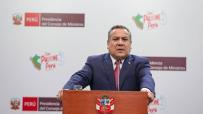
“It's as if they have 'taken hold' of the Nanay; they are holding on because of the quality of the gold," says Bratzon Saboya Torres, the environmental prosecutor for Loreto, the Amazon region that has become one of the new sites for illegal gold mining in Peru. Since a group of miners arrived in the Nanay river basin in 2021, a tributary of the greater Amazon, dredges have multiplied motivated by demand, historic prices, and the high purity of Amazonian gold. Unlike other shipments, the gold extracted from the Amazon is well above 90% of purity.
Along with the dredges and motors, gold buying stores and jewelry stores have also increased in the streets of this region’s capital, Iquitos. But none of this gold appears in the Peruvian government's regional production register. According to the authorities, this illegally extracted mineral from the Nanay riverbed, is transported to Lima or smuggled to Colombia or Ecuador to be laundered using false documentation from supposed miners in the process of formalization or artisanal miners, and is ultimately exported.
An investigation conducted over seven months by OjoPúblico’s Cross-Border Network in five Amazonian countries and involving 18 journalists from five media partners in Latin America, reveals the enormous quantities of gold of non-legal origin exported to the world. Between 2014 and 2023, Peru —the main producer and exporter of gold in South Americav officially produced 1,233 tons of the mineral, but in that same time it exported 4,083 tons. In other words, 70% of the exported gold (2,849 tons) had a non-legal origin.
As part of this investigation, OjoPúblico identified a group of importing companies in India and the United Arab Emirates with nine companies and individuals linked to illegal mining, investigated for money laundering or with final sentences among their suppliers. Through the analysis of data from 10 years of exports, trips into the Amazon territory, interviews with witnesses and review of judicial documents, the route and mechanism behind the laundering and export of gold of illegal origin was reconstructed.
The gold that flies to India
The United States and Switzerland have long led the list of major importers of Peruvian gold, but this situation has changed regularly after the legal proceedings opened for financing illegal mining to several local producers, for facts that OjoPúblico has exposed in investigations.
One of the emblematic cases was that of the Swiss company Metalor Technologies, one of the largest refineries in the world, which announced the ending of its operations in June 2019 following the beginning of investigations of its suppliers, mainly companies located in illegal mining areas of Madre de Dios and Puno.
With the reduced exports to the United States and Switzerland, demand from other countries increased. Since 2020, India and the United Arab Emirates became the fourth and fifth largest export destinations; in both cases gold is the main commodity exported from Peru.
Between 2014 and 2023, Peru has exported 357.23 tons of gold to India. Out of this, 73.65 tons were destined for Kundan Care Products, Kundan Refinery and companies linked to the Kundan Group, one of the most important gold importers in India. This represents 20.6% of all gold sold to the Asian country.

BUSINESS. Kundan promotes itself as an important importer and exporter of gold and silver in India. It is also one of the main Indian buyers of Peruvian ore.
Photo: Kundan Group website
But behind the massive shipment of gold there is a series of suppliers with a long history of links to illegal mining and money laundering from this activity. OjoPúblico identified that the Kundan Group companies have had as suppliers –between 2014 and 2023– at least six companies linked to illegal mining and people convicted of money laundering.
The Kundan Group has among its companies Kundan Care Products Ltd. and Kundan Refinery Private Ltd. engaged in gold-related businesses. "Kundan is also recognized as a major importer and exporter of gold and silver in India, as we have partnered with the largest suppliers of gold and other precious metals worldwide," says on its website.
One of the suppliers of Kundan Care Products Ltd. in Peru was A.L. Copacabana EIRL. On August 28, 2018, the Customs Crime Investigation Division and the Fiscal Police seized four gold bars (34.4 kilos) and a van in Lima; the company was established in 2017 with an address in Juliaca, Puno.
The gold’s owners claimed –during a long judicial process that lasted until 2023– that the mineral came from 25 producers. However, the Attorney General’s office argued that several of the alleged suppliers whom A.L. Copacabana bought the the gold from were not registered in the Integral Registry of Mining Formalization (Reinfo), –that is, they were illegal–, and in other cases the concessions they said the mineral came from showed no evidence of any extraction having taken place there.
Since 2020, India and the United Arab Emirates became the fourth and fifth largest export destinations".
In the sentence for forfeiture of ownership, the Court concluded that the illegal origin of the four gold bars was "verified" and that "their commercialization" was connected to money laundering.
OjoPúblico identified that A.L. Copacabana EIRL began to record exports just one month after starting operations. Between September 2017 and August 2018, it exported 2.36 tons of gold to the Kundan Group.
The same month the police seized gold from this company because of its illegal origin, A.L. Copacabana made seven shipments of between 32 and 47 kilos of gold of up to 95% purity to Kundan Care Products Ltd. According to the commercial records, the last of these shipments departed on August 23, five days before the seizure.
A.L. Copacabana's managing director is Antenor Alexis Luque Chuquija, who has two ongoing preliminary investigations for money laundering and illegal mining, and whose authorization is currently suspended by Reinfo.
Luque Chuquija was for years one of the main importers of mercury in Peru. In 2012, when the import of this toxic element was limited and its sale was considered illegal, he quit his management role. But then, between 2013 and 2014, as OjoPúblico revealed, he incorporated in Bolivia the companies Paloan SRL and A&F Futuro SRL, and resumed the importing of mercury from Mexico, Spain and Japan, at least until 2021.
A.L. Copacabana is not the only supplier of the Kundan Group with a serious track record. The Indian company also bought gold from Trading Express Gold, which between 2015 and 2023 sold 16 tons of gold to it. This company has branches in the main centers of illegal gold production: Coronel Portillo (Ucayali), and in Sandía, Carabaya, La Rinconada and Juliaca (Puno). Its general manager is Wilfredo Borda Luna.
On May 25, 2023, the Special Prosecutor's Office for Money Laundering Crimes seized six gold bars (73 kilos) from this company at an airport warehouse in Callao for not proving their legal origin. At the time, the gold bars were bound to the United Arab Emirates.
Another Kundan supplier is E&M Company, a company established in Cusco. Its general manager, Miguel Zinanyuca Cruz, is part of an illegal mining investigation by the environmental prosecutor's office of Madre de Dios. The case is in its preparatory stage and its origin dates back to 2013. Another person linked to this company is Efraín Vargas Garzón, who was under investigation for alleged money laundering crimes linked to illegal mining.
Vargas was for many years the accountant for the Baca Casas family, one of the most powerful gold mining families in Madre de Dios. The E&M Company accounts for almost 40% of total exports from Madre de Dios.
In May 2014, Peruvian Customs intercepted a load of almost 10 kilos of gold belonging to E&M Company with no documents proving its legality. The agency pointed out that the company failed to detail the exact way in which it moved the mineral from Madre de Dios to Cusco and then to Callao.
Efrain Vargas' registration is currently suspended at Reinfo. Kundan imported from E&M Company 535 kilos between October 2019 and February 2022.
Another of Kundan's suppliers with a record is Romea Contratistas Generales EIRL, a company that in June 2019 had two gold bars of illegal origin seized, each weighing 11 kilos. Earlier that year, between January and March 2019, this company exported 202 kilos of gold to Kundan Care Ltd. The company is currently under an ex officio deregistration with the tax authority.
Between 2014 and 2023, the Kundan Group and its related companies imported a total of 79.97 tons of gold from Peruvian companies, including other destinations such as the United States and the United Arab Emirates.
In its 2022 due diligence policy, the Kundan Group states that, as part of its commitments to ensure that it is buying legally sourced gold, it must look at specialized reports and financial reports from the supplier, as well as conduct extensive Google searches, consultations with local people and interviews by phone.
However, despite the fact that information about the background of some companies, such as that of Antenor Luque Chuquija, had been exposed in journalistic investigations since 2012, Kundan Care still bought the gold from it.
These transactions occur in a context in which Peru and India have just carried out a sixth round of negotiations –which began in 2017– for the signing of a Free Trade Agreement (FTA). Meanwhile, it’s expected from New Delhi’s side that one of the main concerns will be indeed the gold trade, which represents 80% of exports from Peru.
A study on gold marketing circuits in southern Peru published in 2023 in the Journal of Rural Studies by Peruvian researchers Alejandra Villanueva Ubillús and Gisselle Vila Benites points out that traditional markets such as Switzerland, Canada and the United States, which have pushed for reforms in small-scale and artisanal mining in order to ensure responsible supply, now face strong competition from "emerging gold markets" such as India.
Destination Dubai
The Peruvian Government itself acknowledged in 2019 that 32.3% of all gold exported did not have a formal origin. In addition to India, the mineral of suspicious origin is also destined for the United Arab Emirates.
On January 27, 2022, the Fourth Criminal Court of Permanent Appeals of Justice of Callao sentenced Wilber Retamozo Hurtado to eight years in prison for money laundering related to illegal mining.
In November 2015, 8 kilos of gold of illegal origin were seized from him, which had as destination –according to the file to which OjoPúblico had access - the company Al Qutub Jewellery Trading FZE, based in Dubai, the financial capital and city that hosted the 2023 United Nations Climate Change Conference.
According to the testimony presented at sentencing, Wilber Retamozo told the Sunat the gold had been extracted from the Mayo mining concession, located in the district of Inambari, in Madre de Dios. However, when the authorities went to the site, they verified that no mining work was being carried out there. It was an inhospitable area where agriculture, not mining, was being carried out. The gold, therefore, was of illegal origin.
Since 2014, exports to the United Arab Emirates have increased. Al Qutub Jewellery Trading FZE is one of the main importers of Peruvian gold to the United Arab Emirates. Between 2016 and 2017, this company imported 2.7 tons of this metal. But since 2019 it has not registered any more imports.

EPICENTER. The area of La Pampa, in Madre de Dios, is one of the most critical points of illegal mining in the Amazon.
Photo: OjoPúblico / Aldaír Mejía
The frustrated shipment for which Wilber Retamozo was convicted was not the businessman's first. Eight days before his arrest, he exported 7.56 kilos of gold with a purity of 90% to Kundan Care Products LTD, in India.
PMG Overseas Trading FZC, based in the United Arab Emirates, is another importer of Peruvian gold that has a company with a history of illegal mining as a supplier.
On January 12, 2022, the authorities seized a 10.7 kg gold bar, property of the company Korityka Pablo Bamba EIRL, with fiscal domicile in San Ramon (Puno). In this case, as in previous cases, the owners of the gold could not prove its legal origin.
Prior to the intervention, between November 18 and December 16, 2021, this company had already exported 45 kg of gold to Kundan Refinery Private Limited on the A/C PMG Overseas Trading and Altim Metals PVT LTD.
Three other Peruvian companies are facing proceedings and have had illegally sourced gold seized by the authorities: Inversiones Inka Dorada, which in 2020 exported more than 11 kilos of gold to India, mainly to the companies Araya Bullion Trading (6kg) and AJ Gold & Silver Refinery (5 kg); Empresa Minera S.S.Y.O., which between 2020 and 2021 exported more than 130 kilos of gold to the United Arab Emirates, mainly to the companies PG Gold (78 kg).
And there is also Compañía Mining World, which exported from Peru between 2019 and 2020 a total of 394 kilograms of gold to India and the United Arab Emirates, mainly to Augmont Enterprises PVT (151 kg), Sam Precious Metals PVT (52 kg) and Imperial Global General Trading LLC (40 kg).
Discrepancies in official figures
On March 13, 2021 at 8:45 a.m., when he was going through security checkpoints to enter the boarding lounge at the airport in the Amazonian city of Iquitos, in Loreto, Jhonny Alfredo Yarlequé Saavedra was detained with 13 pieces of molten gold wrapped in metallic paper. The traveler –on his way to Lima and then to Piura– could not prove the legal origin of the mineral and refused to sign the record. The seized mineral weighed a total of 577 grams. That incident led to an asset forfeiture case.
As in other cases, gold illegally extracted from the Amazon is laundered in other cities with false documentation associated with mining concessions and then exported or traded. The gigantic differences between what is officially produced and what is finally exported expose the enormous laundering that lies behind it.
According to the database prepared by OjoPúblico, between 2014 and 2023, the export of gold of unknown origin from Peru reached 2,849 tons.

DAMAGE. In the Amazon, illegal mining first advanced along the river and then began with deforestation in regions such as Madre de Dios.
Photo: OjoPúblico / Aldaír Mejía
Sociologist Alejandra Villanueva Ubillús, a researcher at the Center for Mining and Sustainability Studies (CEMS) of the Universidad del Pacífico, believes the main hypothesis for these gaps points to the records of production laundering, which occurs, for instance, in Madre de Dios, with the acquisition of documents from a sanitized concession, or from miners who export directly. This, she argues, is also linked to the obstacles denounced by miners registered with Reinfo.
"Is there an adequate traceability of gold in Peru? No, not at all. That gap [between exports and production] indicates that the laundering is very large, even what is declared we do not know if, in truth, it is being declared with, let's say, truthful documents”, Villanueva says from Belgium. “But I am also quite critical about what we are using these instruments for. I understand that the State, due to the commercial commitments it has, develops these instruments but, at the same time, does this solve the problem of informality?".
Indeed, reports from Peru's Financial Intelligence Unit (FIU) have ranked illegal mining as the main money laundering threat in Peru, well above drug trafficking. Based on financial intelligence reports, FIU estimates that this illegal activity moved around USD USD 7,736 million between January 2014 and February 2024.
"The Reinfo (Registro Integral de Formalización Minera) has become a mechanism for illegal miners to launder the gold they cannot trade. That is why, in Peru, we have these production and export levels. Where does it come from? From illegal mining, which is laundered and formalized," says environmental law attorney César Ipenza Peralta.
Despite all the evidence of how illegal gold is laundered with documents from the formalization process, in the last 12 years, Congress and the Executive have extended the formalization process to informal miners five times. Reinfo currently has 87,000 miners: more than 70% have their rights suspended.
Between 2014 and 2023, Peru produce 1,233 tons of the mineral, but in that same time it exported 4,83 tons".
For public prosecutors from Loreto and Madre de Dios interviewed by OjoPúblico in their own territory, the permanent reopening of Reinfo has become a mechanism of impunity: those registered are exempt from criminal responsibility for the crime of illegal mining.
"In the meantime, you can continue working and extracting in small-scale mining, which implies, first, deforestation; second, soil alteration; and third, if you do it in water bodies, alteration of the receiving body. There is always a damage", explains Julio Guzmán Mendoza, a public prosecutor specialized in environmental matters.
Between 2019 and the end of November 2023, the environmental crimes prosecutor's office has registered a total of 5,123 investigations for illegal mining.
Lack of oversight
Despite this evidence, several bills in Congress insist on weakening mining oversight. There is a new attempt to restructure the Reinfo deadline.
One institution that closely follows the case of the so-called miners in the process of formalization is the Association of Processing Plants and Small Mining Producers (Anplaben), whose manager and vice-president is José Manuel Zegarra Freund. The latter is also general manager of Laytaruma, the third largest exporter of gold volume in the country.
In the last five years, until June 2023, the Specialized Prosecutor's Offices for Environmental Matters (FEMA) in Peru have registered 10,008 cases of illegal mining, according to an analysis made by OjoPúblico of data accessed via information requests. Although several of the most important cases are investigated for money laundering and criminal organization, the data from these prosecutors' offices show the enormous impact of this illicit business.

TOXIC. Peruvian gold exporters include a company linked to one of the main importers of mercury in Peru.
Photo: OjoPúblico / Aldaír Mejía
Madre de Dios is the region with the highest number of reports at the national level, with 1,775 cases. Loreto, where the Nanay River is located, has 86 of such cases; Ucayali, 356; Amazonas, 327, and San Martín, 140.
OjoPúblico learned, according to information from the Peruvian Navy's national port captaincies, that between 2014 and November 2023, only six cases were reported of vessels intervened transporting gold or supplies for illegal mining without documentation. Of these, the majority (5) correspond to the Nanay River in Alto Nanay, Loreto, and one to Madre de Dios, in Isla del Mono (Tambopata).
Between 2014 and 2020, according to the Navy's own official documentation, no interventions were recorded. In 2021 there were two interventions in Alto Nanay, and in 2022, three; in 2023 only one.
New sites and smuggling
In Peru, illegal mining not only destroys forests, but also removes the beds of rivers such as Nanay, Marañón, Putumayo, Napo and Mazán, in Loreto, on the border with Ecuador, Colombia and Brazil, or in the Cenepa river basin, in Amazonas. Some of the illegal gold leaves through airports, some crosses borders, and some is sold to small jewelry stores, according to police and local prosecutors.
Until before the pandemic, illegal mining had its most representative site in Madre de Dios, where it has deforested 83,000 hectares, but in recent years it has spread to Loreto, San Martin and Amazonas. In these areas they operate with people who provide armed security and attack the authorities. "They don't let you pass, they are the owners of the rivers, they have weapons", confirms a justice of the peace in the district of Alto Nanay.
In official records, the only Amazon region that reports gold production, 2014 to 2023, is Madre de Dios. Between 2014 and November 2023, it is the fifth with the highest production at the national level, only after La Libertad, Cajamarca, Arequipa and Ayacucho, regions where large mining companies are located.

THREATENED. The Nanay River, one of the tributaries of the Amazon River, has become the new focus of illegal mining in the Peruvian Amazon.
Photo: OjoPúblico / Aldaír Mejía

IMPACT. Illegal mining is linked to other crimes such as human trafficking and drug trafficking, as well as violating the rights of indigenous peoples.
Photo: OjoPúblico / Aldaír Mejía
In the last ten years, Madre de Dios has officially produced 74 tons. But since 2019, production reports dropped from producing between 7 and 17 tons per year to between 1.3 and 1.6 tons between 2021 and 2023. But this apparent reduction contrasts with what is registered in the territory of Madre de Dios. In recent years, illegal mining has invaded the Tambopata National Reserve, the Amarakaeri Communal Reserve, and the Manu National Park.
The provinces of Carabaya, Sandia and the district of San Gabán, in Puno, which are part of the Andean Amazon, have also become enclaves of illegal mining, says environmental prosecutor Federico Chávarry Cuneo, spokesman for the National Coordinator of Specialized Environmental Prosecutor's Offices. "What has been happening in the southern jungle, which borders between Puno, Cusco and Madre de Dios, is a serious problem because there are areas that can only be accessed by river or helicopter. And there are not enough logistics," he says.
But behind the miner who operates the dredge, the motorist and the diver who dives to the bottom of the river are the groups that finance and profit from the illegal business. Loreto’s prosecutor's office is investigating a case of an alleged criminal organization that has been named "Los Rebeldes del Nanay" (The Nanay Rebels), which is accused of financing this illicit activity. This gang, according to the prosecutor, is integrated by Colombians and Peruvians for whom they have requested 18 months of preventive imprisonment.
Among the four accused –all of whom are free and only two of whom are being held in custody due to restrictions–are the alleged leader of the group and the person responsible for logistics, Colombian nationals Luis Alexander López García, alias Pastuzo, and Jessica Evisa Yauripuma Cabrera, both from Puerto Leguízamo, on the Putumayo side of Colombia, where illegal armed groups are present.
The other two alleged members accused by the prosecution are Diego Fernando Sarria Mora, from Caquetá (Colombia), and Peruvian national Rusbel Bancho Arirama, born in Alto Nanay (Loreto). During the investigation, witnesses have recognized López García and his partner, Jessica Ribeira, as the "owners" or "bosses" of several of the dredges operating on the Nanay River.
Among the evidence found during the raid on their homes were photographs of dredges and engines, images of guns, police surveillance, telephone conversations and vouchers for deposits from Wester Union to the Bancolombia financial institution.
"In different parts of Peru, it’s been noticed that informal miners –not in all cases, but in the vast majority– do not declare what is produced. The little resource they declare does not even come from their own activities but is illegal mining gold that they disguise as informal gold. There are also some formal mining companies that have become complicit of this issue", Prosecutor Chávarry says.
A significant part of the gold illegally extracted from Madre de Dios was smuggled into Bolivia. Prosecutor Chávarry, who is also an environmental prosecutor in Puno, explains it: that gold "is smuggled into Bolivia. There it is laundered and given the formal gold facade," he says.
Bolivia has increased its gold production from 13.4 tons in 2013 to 53 tons in 2022. But, in addition, as this investigation by OjoPúblico's Cross-Border Investigative Network has warned, there is a huge discrepancy between what is produced and what is finally exported. In 2022, for example, Bolivia produced 53 tons, but exported 10 tons more.
Between 2013 and 2024, Customs carried out 103 extraordinary control actions and seized a total of 2,570 kilograms (two and a half tons) of gold intended to be taken out of the country, worth more than USD 108 million. In 99% of the interventions the gold was seized by court order because its legal origin could not be guaranteed. In only one case was it returned after a documentary evaluation.
From 2023 to January 2024, there are 63 cases related to illegal mining activity taken on by the Public Prosecutor's Office Specialized in Extinction of Ownership. Of these, three have final rulings; that is, they no longer admit any judicial recourse. Another 60 are still being processed and are equivalent to 270 gold bars, weighing 998.84 kg, valued at more than USD 65'299,214.
As part of this investigation, OjoPúblico requested the releases of the different persons, entities and companies involved. We sent questionnaires to the Ministry of Energy and Mines (Minem) and to the Superintendence of Tax Administration (Sunat) but did not receive any response.
This publication also sought to contact, through institutional channels, the companies of the Kundan Group. In the case of Kundan Refinery, a person answered via Whatsapp and said that they would soon give an answer. However, at our deadline, they had not answered yet.
OjoPúblico also tried to contact the Korityka Pablo Bamba company, but they said they were not interested in making a statement. In Puno, meanwhile, a press team went to the fiscal address of the Al Copacabana EIRL company. They did not get a response either.
In the case of Al Qutub Jewellery Trading FZE and PMG Overseas Trading FZC, they do not have official websites or other comomunication channels. This publication tried to contact a person related to the former, but we did not receive a response.
 Tienes reportajes guardados
Tienes reportajes guardados

















